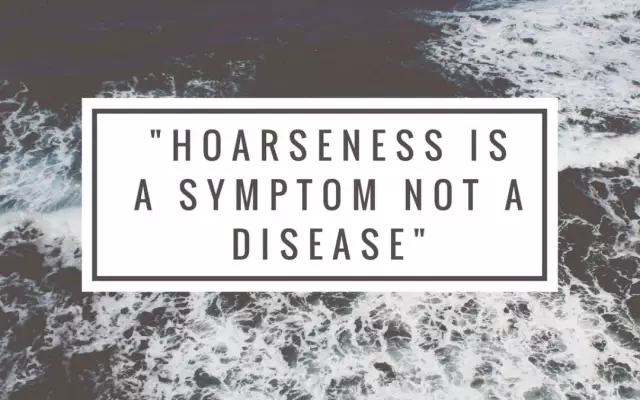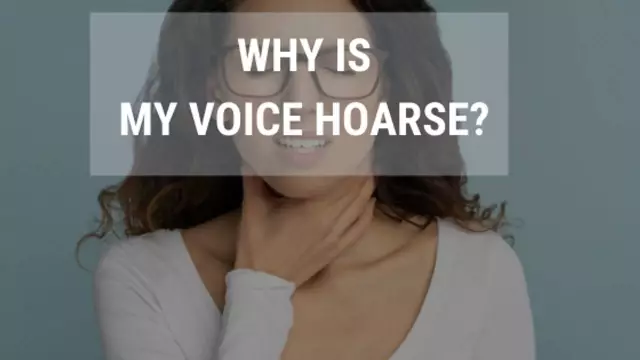- Author Rachel Wainwright [email protected].
- Public 2023-12-15 07:39.
- Last modified 2025-11-02 20:14.
Hoarseness and loss of voice: causes, diagnosis and treatment
The process of forming a voice in a person takes place in the vocal apparatus, where the movement of air is triggered in the energy section - the lungs, and passing through the resonator and articulation sections, turns into a voice. The abdominal and respiratory muscles of the chest with the diaphragm are involved in the formation of the voice. In its formation - the vocal cords located in the larynx, and the oral and nasal cavities are responsible for articulation. The whole process is controlled and monitored by the central nervous system - everything is simple.

Types of voice disorders
The generalized concept defines the types of partial (dysphonia) disturbance or complete (aphonia) absence of phonation. Aphonia, as a loss of voice, apart from a whisper, is not characterized by anything else. Dysphonia has a wider spectrum:
- by volume - a low or too loud voice;
- in pitch - too low or too high (falsetto);
- timbre - hoarse, hoarse voice, monotonous or barking;
- by resonance.
Vocal dysfunction is most often affected by:
- people whose profession is associated with the intensive use of the vocal apparatus;
- adolescents during puberty;
- children and adults with speech disorders - rhinolalia, dysarthria, stuttering.
Causes of a hoarse voice or loss of voice
All causes of voice disorders are divided into 2 categories according to the presence or absence of structural transformations of the vocal apparatus:
- Organic causes - combined by physiological disorders of organs involved in the formation and formation of the voice, including the central nervous system and the brain
- Functional - All voice disorders not associated with organ damage.
Both those and other disorders are divided according to the central and peripheral characteristics.
Chronic laryngitis is one of the most common causes of voice disorders
Organic
Among the organic prerequisites, the main share of voice disorders is occupied by peripheral pathologies caused by inflammation or physiological changes in the organs of the vocal apparatus:
- Chronic laryngitis
- Thermal and mechanical damage to the larynx
- Knot folds
- Laryngeal neoplasms
- Scars after surgery, stenosis
- Other consequences of surgical operations on the larynx.
Functional reasons
The reasons why voice disorders are not associated with damage to the organs of voice formation are called functional, and are also divided into central and peripheral.
Regardless of the reasons that caused hoarseness and loss of voice, it is advisable to include the complex drug Gomeovox in the course of drug treatment. The balanced composition of medicinal herbs provides a softening and anti-inflammatory effect on the larynx and vocal cords.

Various stressful situations and circumstances can affect psychologically and emotionally unstable people in such a way that their nervous system will react with impaired vocal function.
The consequence of strong and prolonged loads on the vocal apparatus can be phonasthenia, the result of which is a disruption in the work of various parts of the vocal apparatus - respiratory, resonator or articulatory.
Violations of the phonasthenic type are characterized by hoarseness and sore throat, partial loss of voice parameters - timbre, tonality, volume. Rapid vocal fatigue occurs during normal vocal stress. The causes of the appearance of disorders are most often overstrain of the ligaments and non-observance of complete rest for the vocal cords during the treatment of diseases of the throat and respiratory tract.
Mutational dysphonia refers to peripheral functional disorders of vocal functions during adolescence. The most common causes of mutational dysphonia are:
- Respiratory infectious diseases - laryngitis and laryngotracheitis affect the vocal cords and provoke the pathological development of the entire apparatus.
- Excessive tension of the voice - during the period of adolescent mutation of the larynx, fixation of functional disorders, expressed in hoarseness, threatens. The risk of such pathologies is at risk for adolescents who ignore the physiological framework of their voice during this period, and also intensively practice vocals.
- The psychogenic factor - neuropsychic pathologies against the background of emotional experiences and upheavals, asthenic syndrome and simply - adolescent tendency to communicate in high tones, turning into a cry - all this leads to functional dysphonia and persistent hoarseness.
- Disorders of the endocrine system - improper production of hormones can affect the formation of hoarseness in adolescents.
During adolescence, puberty, you should be especially careful and careful about your voice
Manifestations of violations
The symptomatology of voice disorders is influenced by the nature of the causes - organic or functional.
Organic:
- Pain and soreness in the larynx, the voice hoarse, and in acute forms it may even disappear altogether - due to the loose closure of the ligaments. These are the consequences of the inflammatory process in laryngitis.
- Neoplasms that have arisen in the larynx, both benign and malignant, tend to grow, and as they grow, they affect the voice - it becomes hoarse, weak or completely disappears. Complete loss of voice is not uncommon after laryngeal surgery to remove neoplasms.
- Loss of voice is a common manifestation of paresis and atrophic paralysis of the larynx. At a minimum, such clinical indications are characterized by hoarseness of the voice, a change in its timbre and oppression of strength.
- A quiet, monotonous, hoarse voice is a characteristic symptom of organic disorders caused by anarthria or dysarthria.
Functional:
- Hoarseness of the voice, rapid fatigue of the ligaments plus pain in the neck - these are the signs of phonasthenia, which is the most common vocal disorder of the functional type.
- Hoarseness of the voice, up to a whisper, is characteristic of a disease such as laryngeal paresis.
- A harsh, deaf, hoarse voice is manifested in a person suffering from laryngeal spasms.
- Changes in the timbre of the voice towards a more hoarse and coarse, or, on the contrary, excessively high, are characteristic of pathology with natural mutation. A breakdown of the voice in adolescence threatens to further fix such violations.
Hoarseness and hoarseness of the voice are the main signs of functional disorders of the vocal apparatus. Aphonia, as a loss of voice, is less common than with anatomical disorders.
Diagnostics
Doctors of specialized specialties can make an accurate diagnosis:
- Otolaryngologist - examines anamnesis, conducts examination and ENT diagnostics for physiological changes or inflammatory processes in the organs that make up the vocal apparatus. In his "arsenal" such studies as laryngoscopy, stroboscopy, X-ray and MSCT.
- A speech therapist or a specialist in a direction more focused on the voice - a phonopedist, studies the functional characteristics of disorders and compiles a correction strategy.
Treatment of voice disorders
Medication for voice disorders is used in the presence of inflammation
The strategy for correcting voice disorders depends on the results of diagnostics and, accordingly, on the causes of voice disorders. Physiological causes of hoarseness or hoarseness of the voice are eliminated by a number of medical measures:
- manual therapy of the front of the neck;
- Exercise therapy;
- physiotherapy procedures;
- a course of restorative treatment.
As part of the course of treatment, drugs specially designed to restore the voice, such as Homeovox, show high efficiency. Their action from the first days of use has a beneficial effect on the restoration of the functions of the larynx and vocal cords, and the composition has no age restrictions and is combined with any drugs.
The most important factor in the effectiveness of speech therapy restoration of voice disorders is the timeliness of its application to exclude psychological and physiological fixation of pathologies. Simply put, the earlier the process of restoring voice functions with speech therapy methods is launched, the more effective they are. There are enough such methods:
- restoration of correct breathing;
- psychotherapeutic course;
- breathing and articulation exercises;
- formation of coordination between phonation and articulation of phonopedic exercises.
On average, the duration of voice restoration is from 2 to 4 months with strict adherence to all prescribed procedures and voice mode. The result of recovery is a voice of normal strength without signs of fatigue and discomfort, with correct breathing.
Found a mistake in the text? Select it and press Ctrl + Enter.






